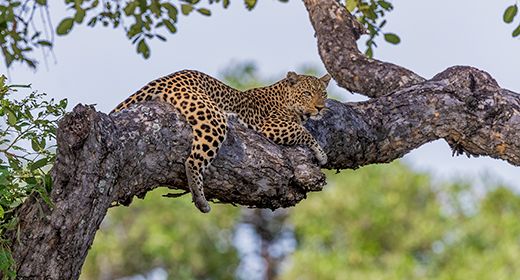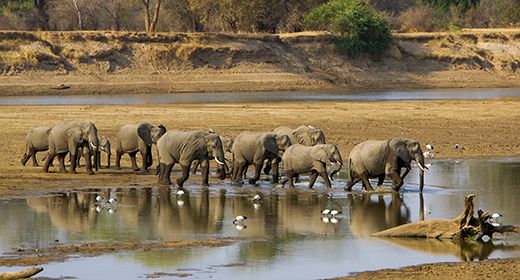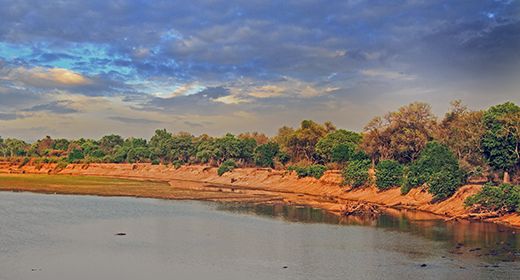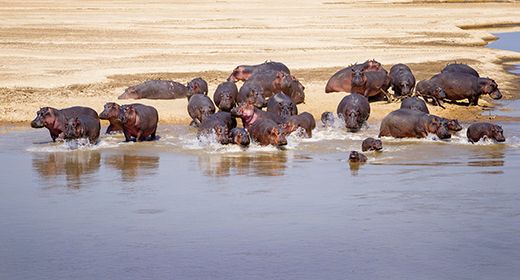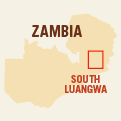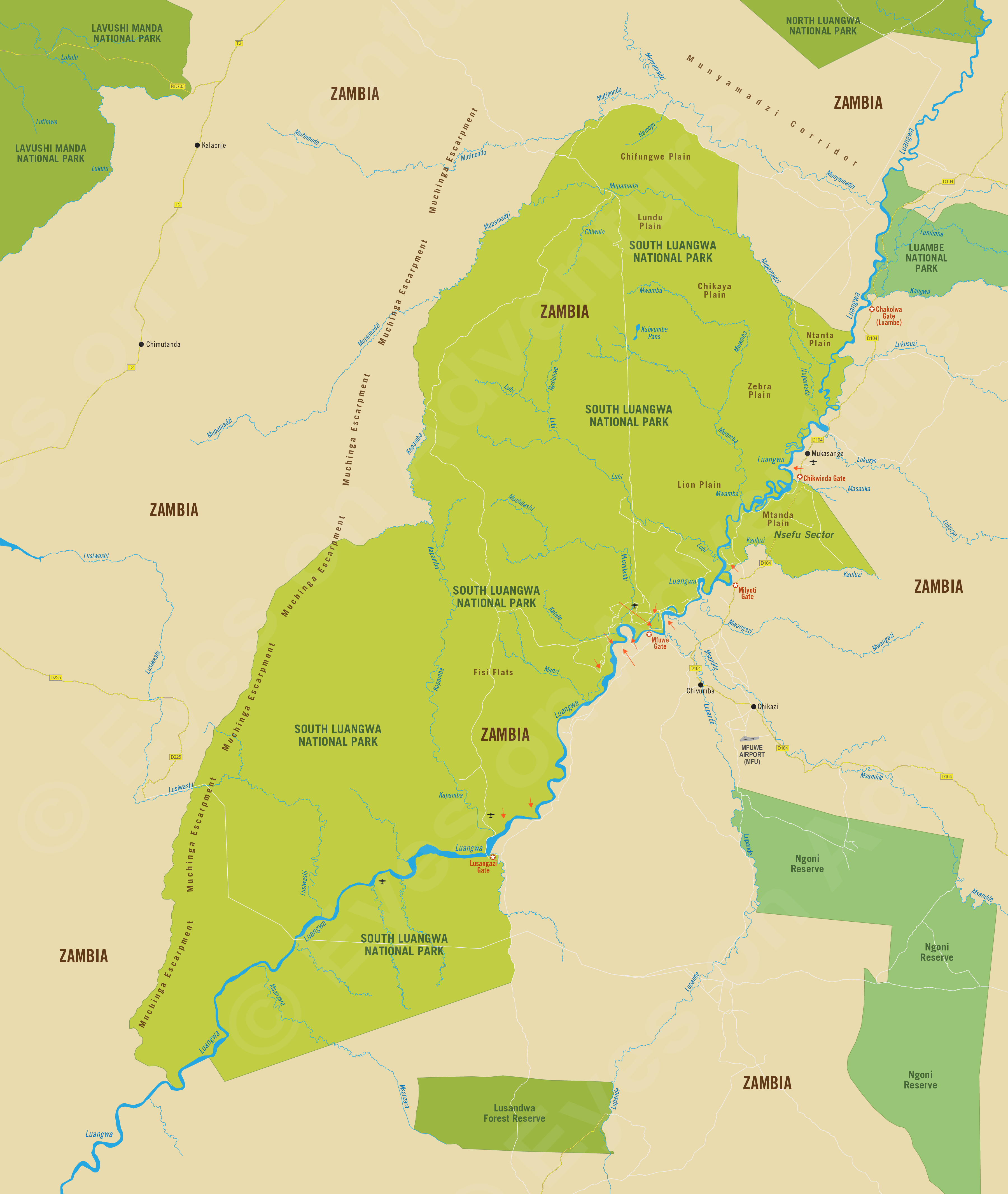South Luangwa
(incl. South Luangwa National Park)
Region Links: Kafue, Livingstone, Lower Zambezi (Zambia), North Luangwa, South Luangwa
Highlights
- Zambia's top wildlife destination
- Wild and remote with abundant and diverse wildlife
- Lots of predators, including lion, leopard, spotted hyena and wild dog
- Africa's best walking safaris
- High level of seasonal variation
EOA Recommends: Chindeni Bushcamp, Luangwa River Camp, Mfuwe Lodge, Nkwali Camp, Nsefu Camp, Tena Tena Camp
South Luangwa is Zambia's premier safari destination. Set in the wild and remote Luangwa River Valley, the park offers excellent safari camps and extraordinarily diverse and abundant wildlife.
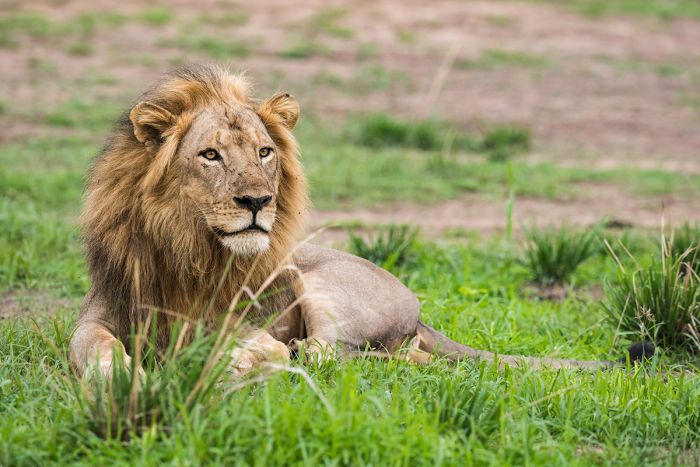
A male lion in South Luangwa National Park
Few parks in Africa can match South Luangwa's high wildlife densities, especially in such a pristine wilderness setting. The park gets is life from the Luangwa River, which flows through the fertile Luangwa Valley, which is home to large numbers of predators, plains game, and birds.
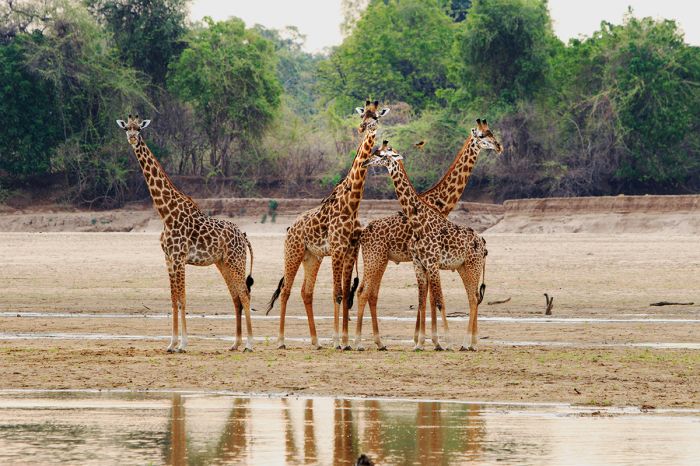
Giraffes on a sand bank along the Luangwa River
Luangwa is known for its plentiful elephants, predators including lions, leopards, spotted hyena, and African wild dogs, diverse plains game including giraffe, zebra, puku, buffalo and many more. Of Africa's Big Five animals, only rhinos are missing. Birding in the park is excellent with plenty of raptors, water birds, and woodland species.
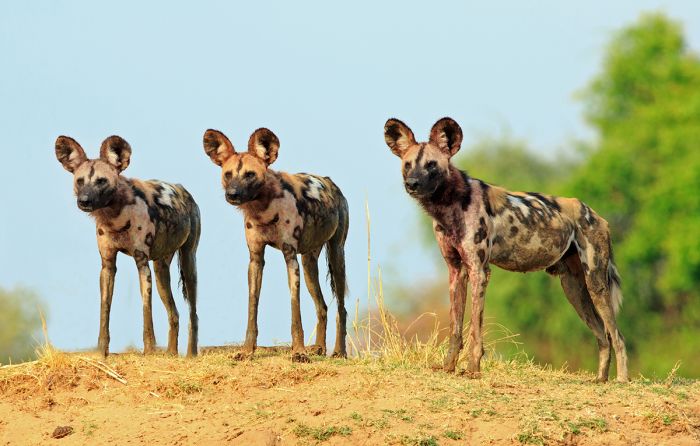
African wild dogs are seen often in South Luangwa
Africa's popular 'walking safaris' originated in South Luangwa and are available in many of the more remote camps in the north and south of the park.
The Luangwa Valley is a place of great seasonality and during the rainy season (between November and April), many camps are closed due to inaccessibility.
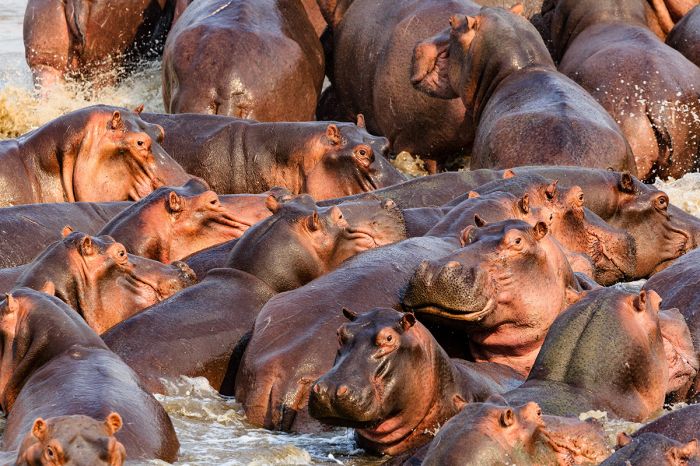
The Luangwa River is home to thousands of hippos
Read More...
Geography, History, Luangwa River, Norman Carr, Poaching, Walking Safaris, Wildlife
History
Archeological discoveries in the Luangwa Valley indicate that early humans have inhabited the region for at least two million years. Stone tools discovered also show that the region was inhabited by our ancestors throughout the Stone Age and that pastoralist farmers arrived around 400 AD.
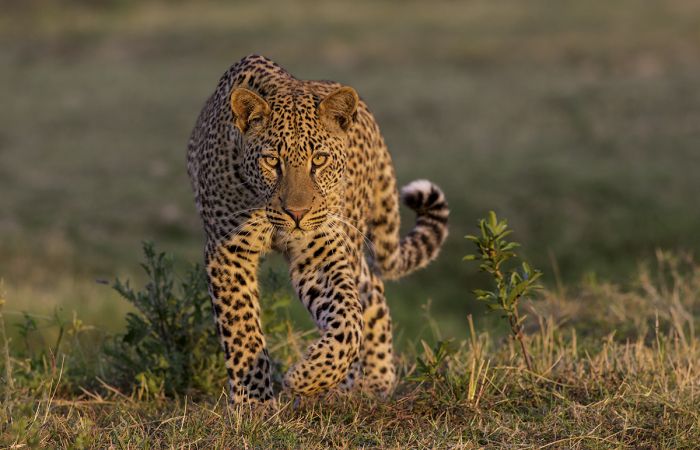
South Luangwa is known for its high density of leopards
The Zambezi River, into which the Luangwa River flows, was a burgeoning trade route from the interior to the coast of Mozambique as early as the 1700s. Small Portuguese settlements were formed along the Luangwa River, including the townships of Zumbo and Luangwa, at the confluence of the Luangwa and Zambezi rivers.
Numerous European explorers, game hunters, and fortune-seekers traversed the Luangwa Valley throughout the 1800s, and it gained a reputation for having extremely rich wildlife. David Livingstone, who crossed the Luangwa River north of the Nsefu region in 1866, described the Luangwa Valley as one of the richest lands he had ever seen.
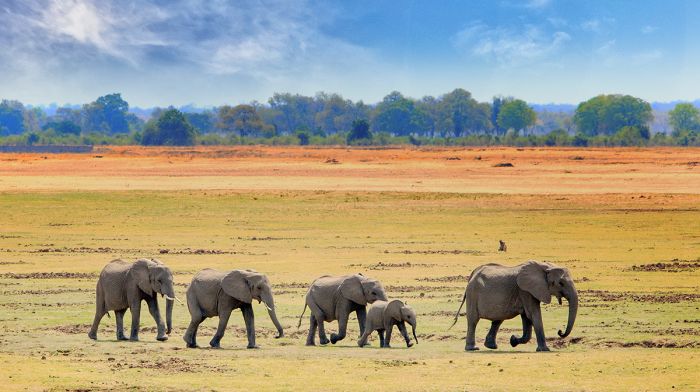
An elephant family in South Luangwa National Park
The first official protected land was declared as the Luangwa Game Park in 1904 along the eastern bank of the Luangwa River, but lack of maintenance and enforcement led to the abandonment of the park.
In 1938, three new protected areas were declared in the Luangwa Valley, the South Luangwa Game Reserve, the North Luangwa Game Reserve, and the Lukusuzi Game Reserve (located further to the east). The South Luangwa reserve was roughly the same area as the national park today, only excluding the Nsefu Sector and the Chifungwe Plain in the far north.
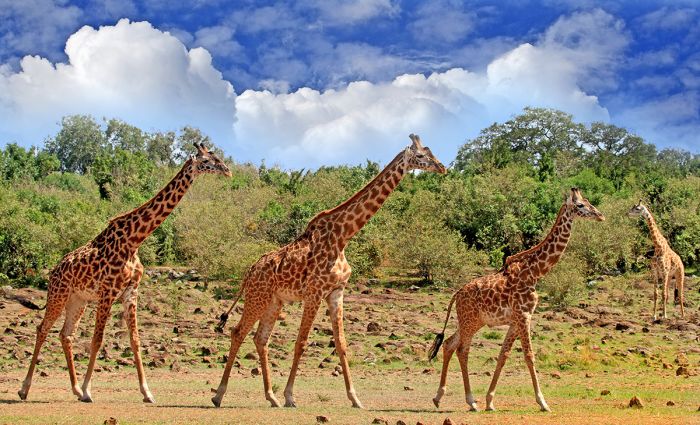
Giraffes in Zambia's South Luangwa NP
Norman Carr
In 1939, Norman Carr, a British Conservationist, was appointed game ranger overseeing the new game reserves, and villagers living within the reserve boundaries were relocated outside the reserves. Carr was a visionary ahead of his time and during an era where safaris were focused on hunting, he began petitioning for conservation-based tourism, where animals were viewed, but not killed.
In 1949, Carr worked with Chief Nsefu, the leader of the Kunda tribal people in the Luangwa Valley, to create a private game reserve on the eastern bank of the Luangwa River (which is now called the 'Nsefu Sector').
Carr built an ecotourism safari camp (Nesfu Camp) in the reserve and channeled a portion of its revenues into the local community. In 1972, new national legislation dictated that all game reserves in Zambia become national parks, and the Nsefu Sector was absorbed into the South Luangwa National Park.
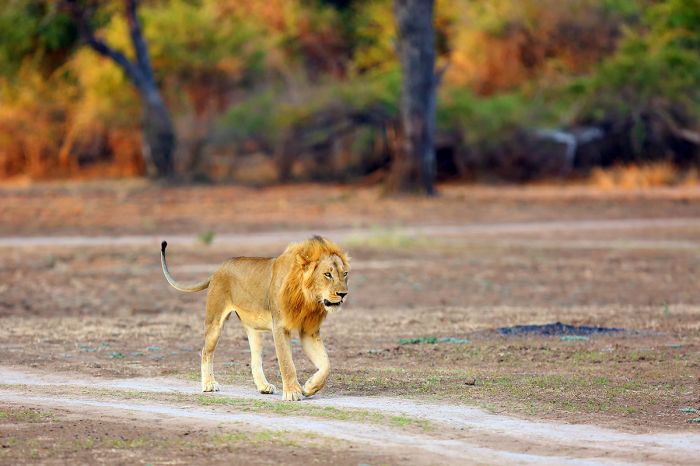
A male lion strolls down a South Luangwa road
Carr is also credited with pioneering the modern walking safari, which he led for guests staying at his lodge and upon which South Luangwa gained much of its reputation as 'the' place to visit for this type of new adventure.
Carr remained an influential and important advocate for including local communities in the commercial success of the safari industry thought the remainder of his life, which ended in 1997. His outspoken example of cooperation between safari operators and local communities is still being followed today.
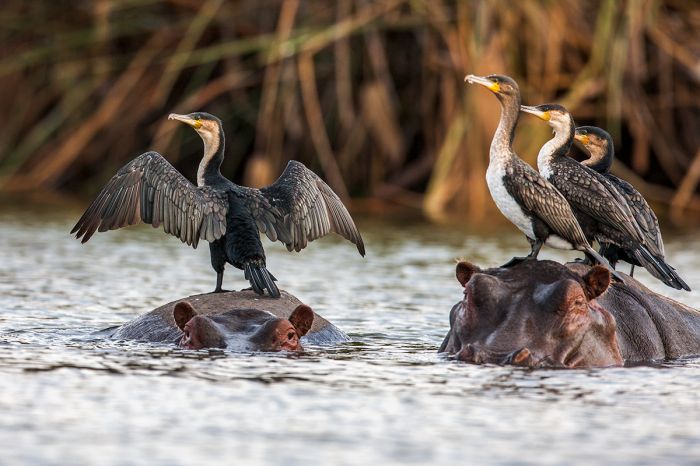
Hippos and great cormorants in the Luangwa River
Poaching
During the late 1970s and early 1980s, increasing demand for ivory and rhino horn in Asia led to heavy poaching of Africa's elephants and rhinos. Some countries, like Kenya and Botswana, instituted a shoot-to-kill policy, allowing poachers to be shot on sight, which stemmed losses in those countries, but Zambia, which had no such policy, suffered from rampant poaching, even in their national parks.
Commercial poachers armed with automatic weapons like AK-47s, decimated wildlife in the Luangwa Valley. From a population of around 85 000 elephants in the 1960s, Luangwa's elephants were hunted down to around 5 000 by the late 1980s. Unfortunately, all of Luangwa's rhinos were lost to poaching and they no longer exist here.
Today, Luangwa's elephant population is still rebounding and estimated to be around 18 000 and poaching has mostly been eliminated.
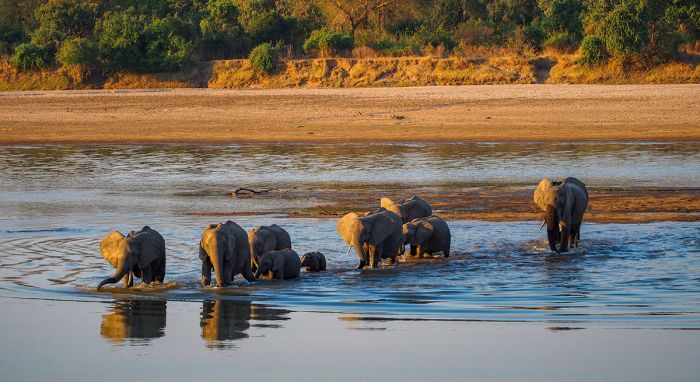
Elephants crossing the Luangwa River, Zambia
Geography
South Luangwa National Park covers 3 361 square miles (8 704 sq kms) in the fertile Luangwa River Valley in Eastern Zambia. The valley's elevation ranges between 1 600-2 600 feet (500-800 meters) and the western boundary of the park is defined by the Muchinga Escarpment. The terrain slopes downward from the escarpment in the west to the valley floor and the Luangwa River, which forms most of the eastern boundary of the park.
The terrain near the Luangwa River is mostly flat, with mature woodlands and some dense thickets of bush. The northern part of the park is defined by various open plains, but not short-grass plains like in the Serengeti, but rather open land covered with tall grass, some bushes and very few trees.
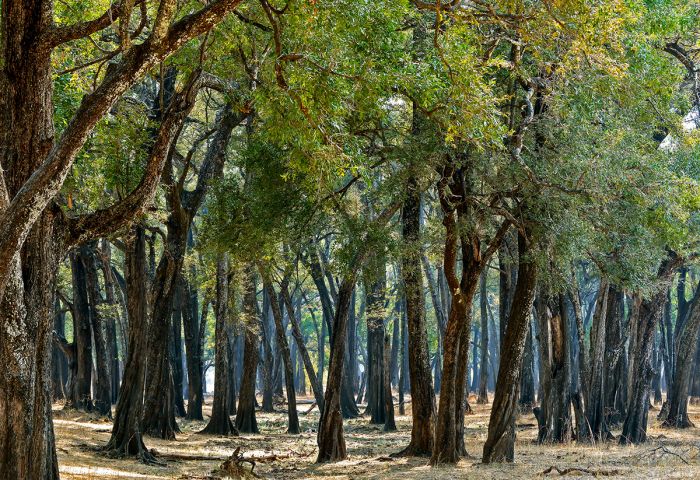
Mahogany tree forest in South Luangwa
The Luangwa Valley is in itself a rift (the Luangwa Rift) and forms a southwest extension of the Great African Rift, which reaches all the way north to the Red Sea.
Roughly one million years ago, there was no exit from the Luangwa Rift and it filled with water, creating a large Rift Valley lake called Lake Madumabisa, which was nearly the size of Lake Malawi. Overflow from the massive lake flowed far to the southwest towards the Kalahari, where it joined the Okavango River, Zambezi, Cuando and Kafue Rivers.
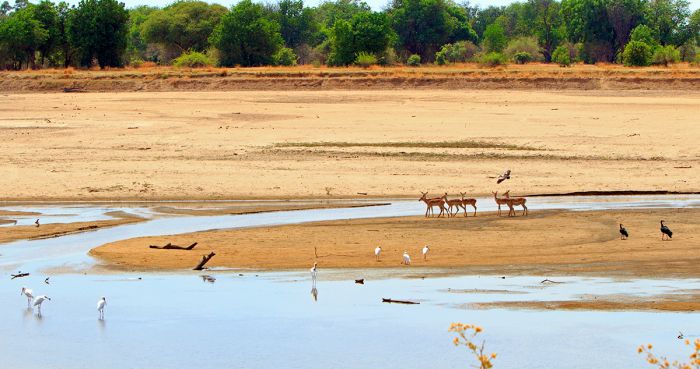
Impalas and various birds on the Luangwa River
Luangwa River
The Luangwa River is the most notable feature of the park and the entire region. It is a pristine waterway, with no dams and no commercial farming long its banks, making it one of the world's largest rivers that has been virtually unaffected by human activity.
The variation in water flow that is created by the substantial rainfall in the region during the summer months, means that the river levels rise and fall dramatically. Over time, the river has cut into the soft valley floor, creating fluctuating courses with multiple oxbows, back flows and pools.
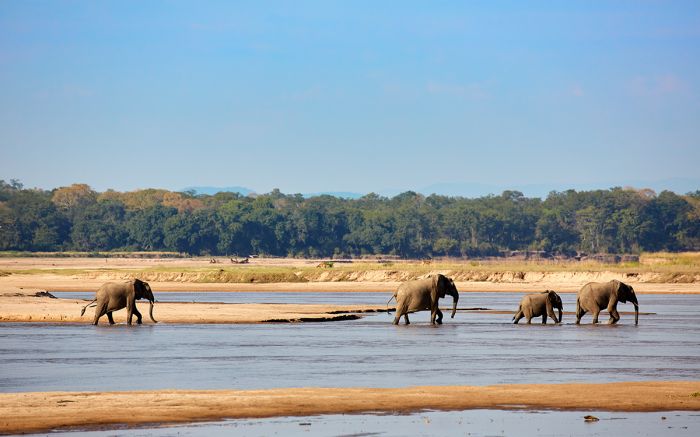
Elephants crossing the Luangwa River
The Luangwa River flows to varying degrees all year, but the numerous tributaries that join it are dry sand rivers for most of the year and only flow sporadically during the rainy months (Dec-Apr). Even so, there are mature woodlands of mahogany, ebony, and mopane trees along these smaller rivers, especially at their confluence with the Luangwa.
Owing to the excellent habitat and permanent water along the Luangwa River, wildlife densities are highest along its banks and most of the park's safari camps are understandably situated along the river.
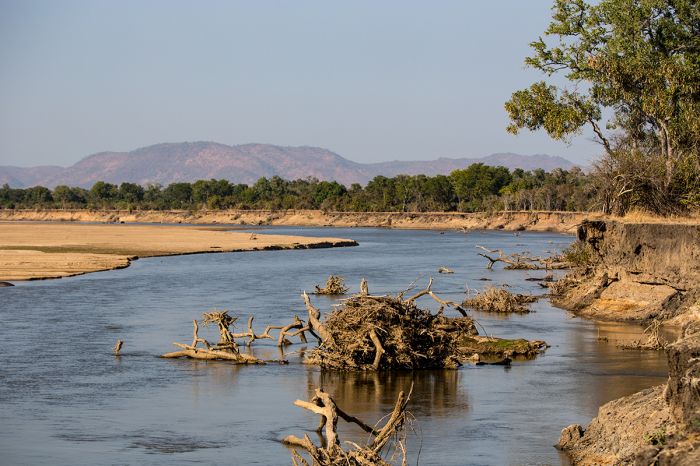
Exposed sand banks show the extent that the Luangwa River rises
Wildlife
South Luangwa's volcanic soils, which are rich in nutrients, combined with the sediments carried into the valley by the Luangwa River and its tributaries, have created a vegetation-rich ecosystem. The park's variation of biomes, from mature woodlands, open grasslands, and riparian bush, creates excellent habitat for a large variety and abundance of herbivores.
Big herds of buffalo, often numbering in the hundreds, are commonly encountered. Despite the past issues with elephant poaching, South Luangwa has plentiful elephants and they are easily seen along the river. Most of the elephants are used to game drive vehicles and are relaxed and a pleasure to observe.
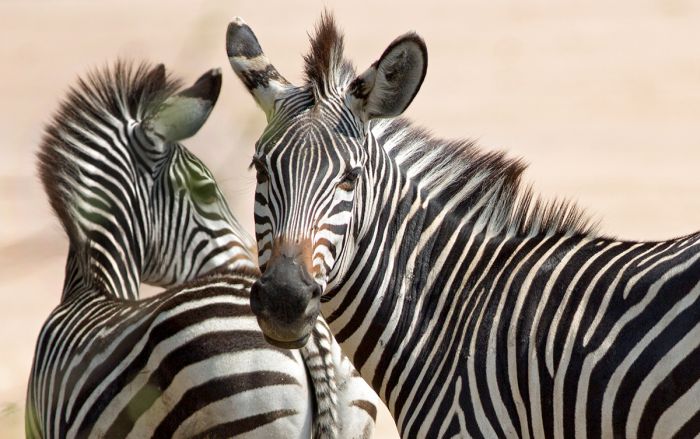
Crawshay's zebras, a regionally endemic subspecies found in South Luangwa
The most common antelope species in Luangwa are puku. They are often seen in sizable herds, especially near the river. Impala, typically the dominant species throughout much of Southern Africa, are also found in great numbers in the park.
Luangwa is home to several subspecies of more common animals, including giraffe, zebra, and wildebeest. These Luangwa 'specials' include Thornicroft's giraffe, Crawshay's zebra, and Cookson's wildebeest.
Other herbivores seen around the river include common waterbuck, bushbuck, kudu, eland, and oribi. Reedbuck and Lichtenstein's hartebeest are found away from the river. Sable and roan antelope are found in the hills closer to the Muchinga Escarpment.
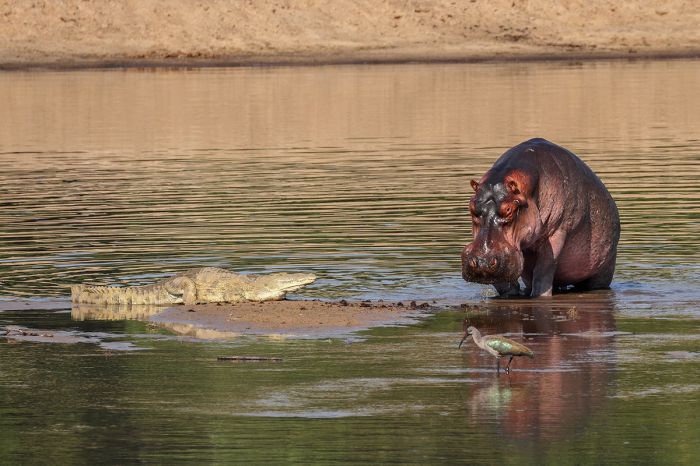
The Luangwa River is home to an abundance of hippos and crocodiles
The Luangwa River itself is home to huge numbers of hippo and crocodile. The hippos in particular are here in great abundance and by the end of the dry season, when water in the river has dramatically decreased, they are often be seen in aggregations numbering in the hundreds.
South Luangwa is also home to healthy populations of predators, including lion, leopard, African wild dog, and spotted hyena. Lion are by far the most common large predator and the easiest to find, as they form big prides, which prey on buffalo and the other large herbivores. The park is also well known for its very high density of leopard, which can often be found resting in trees during the day and on the prowl if you go on a night game drive.
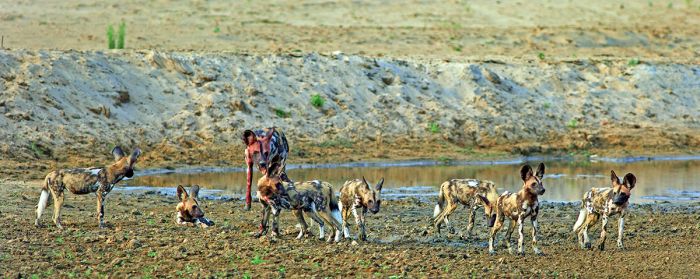
African wild dogs, including first-year pups, in South Luangwa
Packs of African wild dog are also often encountered. They are prone to hunting very early in the morning or at dusk, while during the day, they prefer to rest up in the mature woodlands near the rivers. Spotted hyenas are common and may be seen any time of day or night. Cheetah are not found in the Luangwa.
Birding in South Luangwa is superb, with over 400 species recorded. The best time for maximizing species is in the late Spring (Sep/Oct) and during the rainy summer months (Nov-Mar), when many migrant species arrive from the north to breed.
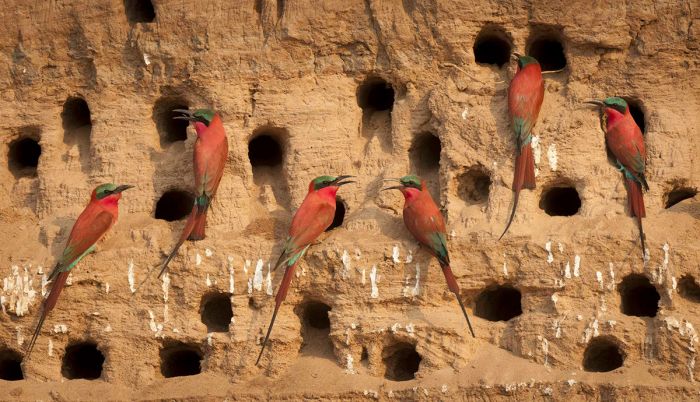
A southern carmine bee-eater communal nesting site in the river bank
Walking Safaris
South Luangwa is credited as being the birthplace of the commercial walking safari in Africa. Norman Carr, the first warden of the national park and subsequently a safari camp owner, was the pioneer of South Luangwa's walking safaris for eco-tourism.
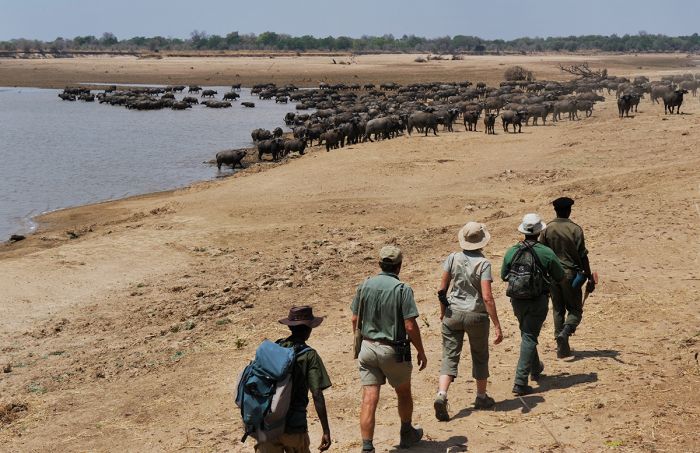
Walking safari and buffalo herd in South Luangwa (Copyright © Remote Africa)
Today there are numerous guest camps in South Luangwa that offer expertly guided, multi-day walking safaris. The itineraries vary depending on the season and operator, but typically follow the design of walking during the day and sleeping in a different camp each night. Most walking safaris take place at the bush camps located in the north or south of the park, away from the more congested central Mfuwe area.
Some camps also offer half-day or single-day walks for guests wishing to get a small taste of this experience without embarking on a multi-day walk.
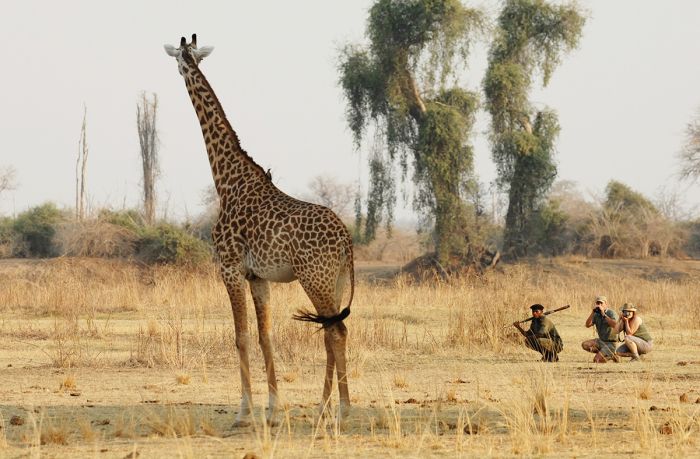
Walking safari and giraffe in South Luangwa (Copyright © Remote Africa)
Read More...
Geography, History, Luangwa River, Norman Carr, Poaching, Walking Safaris, Wildlife
Great Good Fair Poor
- Jan
- Feb
- Mar
- Apr
- May
- Jun
- Jul
- Aug
- Sep
- Oct
- Nov
- Dec
South Luangwa has very distinct seasons, which are defined by rainfall. The temperatures are consistently warm to hot during the day throughout most of the year. Game viewing is best during the dry winter months and some safari camps close for the peak rains during the summer.
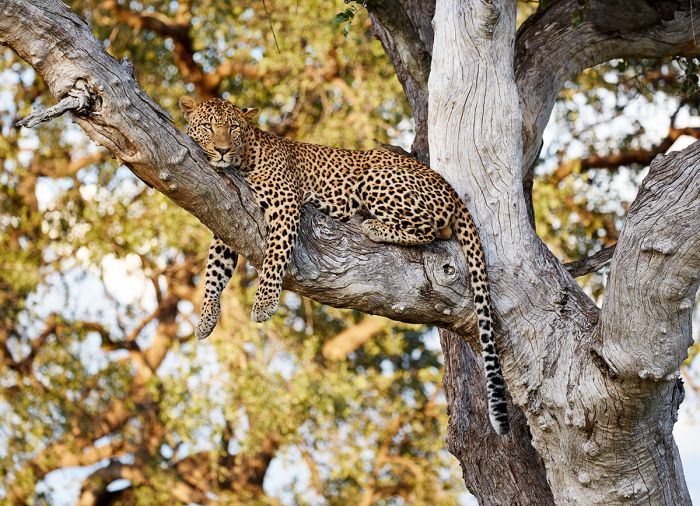
A leopard in South Luangwa National Park, Zambia
Winter / Dry Season
Luangwa's dry season runs from May thru October and during these months, there is virtually no rain. Days are warm and nights are comfortably cool. The dry season is peak time for tourist numbers and offers exceptionally good wildlife viewing.
May marks the end of the rainy season and there is still lots of water on the ground and the vegetation is thick and lush. Some late rainfall is possible.
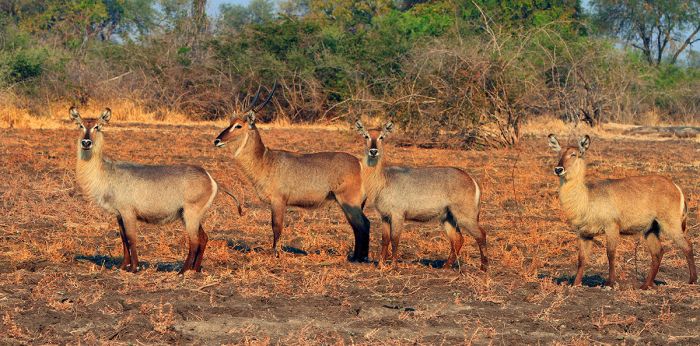
Common waterbucks during the dry, winter season
June/July are rain-free and the vegetation is changing from green and lush to brown and dry. These are the coolest months in Luangwa, but daytime temps still average 80-82°F (27-28°C). Overnight temps fall to a comfortable 50-52°F (10-11°C). Game drives in the morning will start out quite chilly in the open air, so bring layers and fleece to wear and shed as the morning warms.
August/September are hot and dry and offer the year's best game viewing, with most ground water completely dried up except for the Luangwa River, where most of the wildlife congregates. Daytime temps continue to increase, averaging 90-92°F (32-33°C) and overnight temps are between 57-64°F (14-18°C).
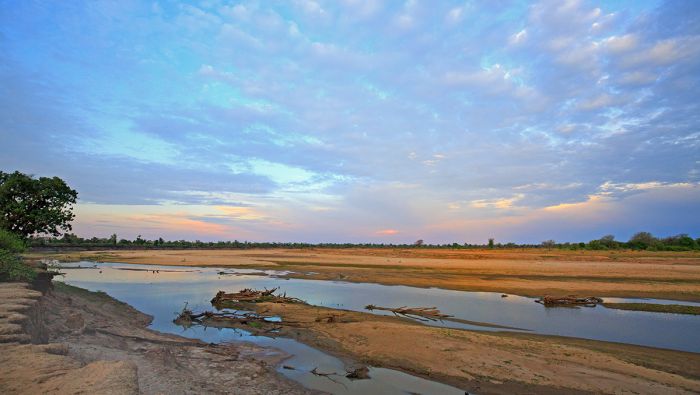
The Luangwa River before the arrival of the rains
October is the peak of the dry season until the first rains arrive, which often occurs sometime during the month. Daytime temps are still on the rise, with daytime temps reaching 95-97°F (35-36°C), making this the hottest time to be in the park. Morning temps are very comfortable at 65-68°F (18-20°C), but it warms up quickly, so game drives start and end early.
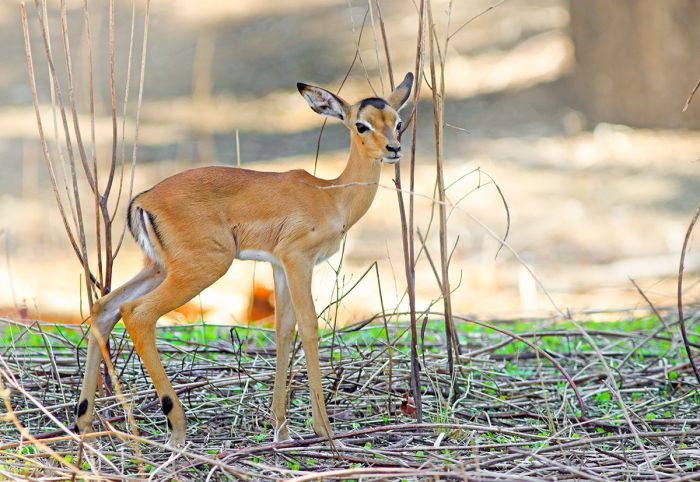
Impala babies arrive at the start of the rainy season
Summer / Rainy Season
Luangwa's rainy season runs from November thru April. Portions of the park become unreachable, as some roads become blocked by water and are unsafe to drive. Vegetation becomes thick and lush as the rain increases and some camps are closed for part of the season.
November is very hot, with sporadic rainfall that comes as a relief for the animals that have waited out the long, dry winter. The bush explodes with verdant new growth and ground water pools begin forming, which means some of the wildlife can begin moving away from the permanent water of the Luangwa River. Daytime temps still reach 93-95°F (34-35°C) and nights are warm at 60-63°F (16-20°C).
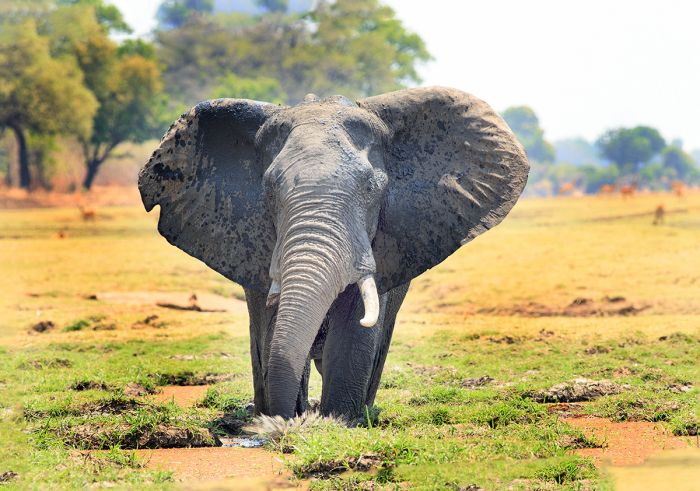
A bull elephant enjoying the wet summer in South Luangwa
December thru March bring Luangwa's peak rains, with daily showers likely, although rarely is it an all-day rain. Many roads, especially near the Luangwa River, become flooded or too muddy to traverse, limiting the game drive road network and most game drives focus on the raised main roads in the park. Wildlife is more dispersed away from the Luangwa River, with plentiful food sources and water available throughout the park.
Daytime temps are warm and humid, averaging 85-89°F (29-32°C). Overnight temps average 64-71°F (18-22°C). Some safari camps are closed during this period.
April is the end of the rainy season and rainfall is sporadic and decreasing in intensity. The bush is still very thick and animals are dispersed. Daytime temps average 84-86°F (29-30°C) and nights are warm at around 66-68°F (19-21°C).
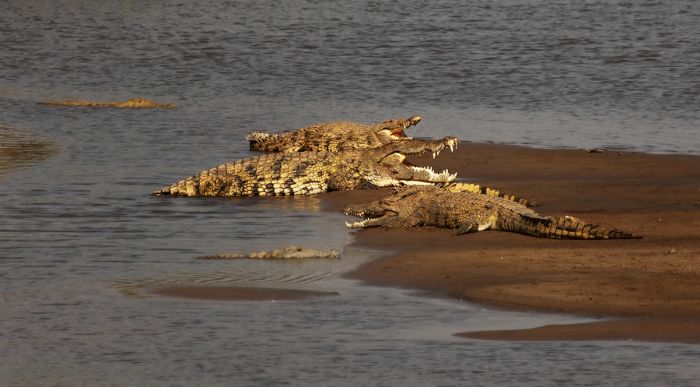
The Luangwa River harbors huge numbers of crocodiles




